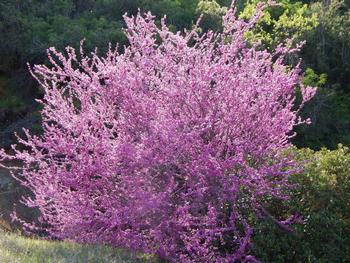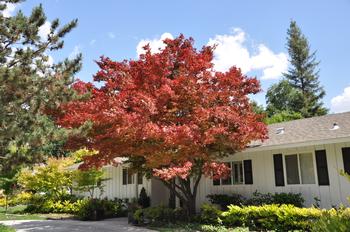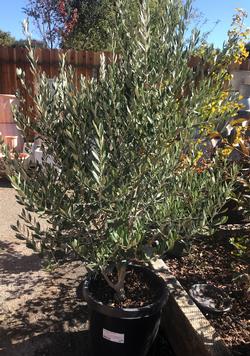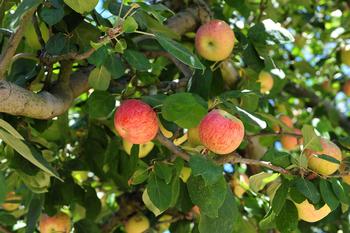Plant the right tree in the right place
-
Marty Nelson
-
 Native Western redbud (Cercis occidentalis), is a drought-tolerant and showy landscape tree choice. Photo credit: UC Regents
Native Western redbud (Cercis occidentalis), is a drought-tolerant and showy landscape tree choice. Photo credit: UC Regents
Planting a tree is an investment in the future. The practical and aesthetic benefits that a tree provides can last for generations. Planting a tree is also a way to fight climate change. By removing carbon dioxide and pollutants and releasing oxygen, trees make the air we breathe healthier. Trees help save energy by providing shade and lowering surface and air temperature. They shelter wildlife and support environmental biodiversity. Additionally, trees bring us beauty and enjoyment. Can’t we all remember trees that have held special meaning throughout the years?Because trees are so valuable, it is important to choose them carefully. Both practicality and preference should be considered in tree selection. Although it is tempting to bring home a pretty little tree from the nursery and then decide where to plant it, you will have better success if you do some initial planning. First you need to determine what you want the tree to do. Do you want it to provide shade, wind protection, noise reduction, privacy, edible fruit, colorful flowers or seasonal foliage? If you want shade, then choose a tree with a large canopy. A deciduous tree will provide shade in summer and allow sun through when its leaves drop in the fall. Tall, dense trees can provide screening and privacy. Evergreens are a good choice for blocking wind and noise. Although fruit trees are primarily chosen for the type of fruit they produce, they too can offer shade. Trees with showy flowers or foliage make good specimen trees and add interest to your garden. Avoid planting a large tree too close to a house where overhanging branches can pose a fire risk. Photo credit: GardenSoftOnce you have decided on its function you should consider location and the size of the tree at maturity. You want to select a tree that is adapted to your climate zone and can grow in your garden conditions. Is the site you are considering in full sun or partial shade? Will the tree be exposed to wind or frost? Soil type and the availability of supplemental water should also guide your tree choice. Some trees prefer fast-draining soil while others will tolerate heavier clay soils. Drought tolerant trees are a good choice in many locations but they won’t thrive near a lawn. Visualize the height and spread of the tree. Your tree will need enough space to grow to maturity and not become overly large in relation to structures and other plants. Pay attention to overhead power lines and underground utilities when deciding on tree size and planting location.
Avoid planting a large tree too close to a house where overhanging branches can pose a fire risk. Photo credit: GardenSoftOnce you have decided on its function you should consider location and the size of the tree at maturity. You want to select a tree that is adapted to your climate zone and can grow in your garden conditions. Is the site you are considering in full sun or partial shade? Will the tree be exposed to wind or frost? Soil type and the availability of supplemental water should also guide your tree choice. Some trees prefer fast-draining soil while others will tolerate heavier clay soils. Drought tolerant trees are a good choice in many locations but they won’t thrive near a lawn. Visualize the height and spread of the tree. Your tree will need enough space to grow to maturity and not become overly large in relation to structures and other plants. Pay attention to overhead power lines and underground utilities when deciding on tree size and planting location. A European olive tree (Olea europaea), needs space to grow to a 25-30 foot height and spread at maturity. Photo credit: Marty Nelson
A European olive tree (Olea europaea), needs space to grow to a 25-30 foot height and spread at maturity. Photo credit: Marty NelsonHaving narrowed your choices, you may settle on a deciduous tree to provide shade to the southwest corner of your house where there will be no utility interference. Choose a planting location far enough away from your house to avoid root damage to the foundation and anticipate a fire-safe distance of at least ten feet between mature tree branches and the roof or other structures.
 Fruit trees provide shade in addition to flowers and fruit. Photo credit: UC Regents
Fruit trees provide shade in addition to flowers and fruit. Photo credit: UC Regents
You also need to consider growth rate. Fast-growing trees, like sycamores, can provide shade within a few years, but tend to be relatively short-lived, needing to be replaced in around twenty-years. Oaks, on the other hand, grow more slowly and are trees to plant for posterity. Some trees have aggressive or shallow root systems making landscaping around them more difficult. Don’t forget the messiness factor. Trees that drop considerable amounts of flowers, fruit, or foliage mean more cleanup and potential hazards on walkways. Finally, you want a tree that is earth friendly, one that is drought tolerant, fire resistant, and non-invasive. Native trees are good options for environmental sustainability.
When you have determined the type of tree you want, assessed the site conditions, and considered cultural needs, you are ready to find your tree. Talk with arborists and nursery staff. Visit parks, neighborhoods, and botanical gardens to look for mature specimens of trees you are considering. Websites such as selecttree.calpoly.edu and calscape.org offer tree selection programs. A tree chosen with care will bring you years of enjoyment.




